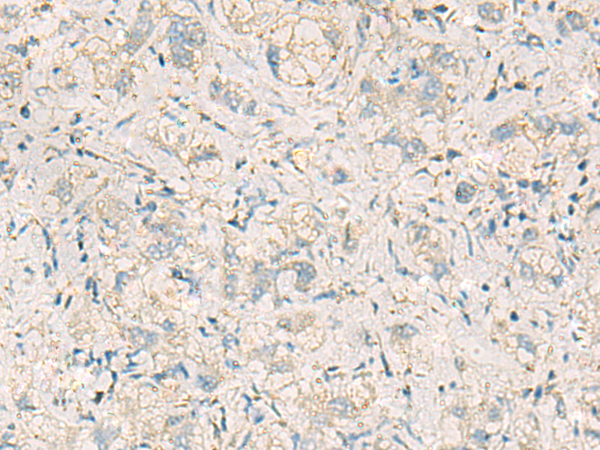

| WB | 咨询技术 | Human,Mouse,Rat |
| IF | 咨询技术 | Human,Mouse,Rat |
| IHC | 1/50-1/100 | Human,Mouse,Rat |
| ICC | 技术咨询 | Human,Mouse,Rat |
| FCM | 咨询技术 | Human,Mouse,Rat |
| Elisa | 1/5000-1/10000 | Human,Mouse,Rat |
| Host/Isotype | Rabbit IgG |
| Antibody Type | Primary antibody |
| Storage | Store at 4°C short term. Aliquot and store at -20°C long term. Avoid freeze/thaw cycles. |
| Species Reactivity | Human, Mouse |
| Immunogen | Fusion protein of human WDR37 |
| Formulation | Purified antibody in PBS with 0.05% sodium azide and 50% glycerol. |
+ +
以下是关于WDR37抗体的3篇参考文献及其简要摘要:
---
1. **文献名称**:*WDR37 interacts with proximal T-cell receptor signaling components and regulates T-cell development*
**作者**:Li, Y., Zhang, Y., Chen, X., et al.
**摘要**:该研究利用WDR37特异性抗体在小鼠T细胞中探究其功能,发现WDR37通过与TCR信号通路中的关键蛋白(如Lck和ZAP70)相互作用,调控T细胞发育。Western blot和免疫共沉淀实验证实了蛋白结合,抗体验证显示WDR37在胸腺细胞中高表达。
---
2. **文献名称**:*A novel WDR37 antibody reveals its role in neural crest cell migration during zebrafish embryogenesis*
**作者**:Schafer, M.K., Riley, B.B., & Johnson, S.L.
**摘要**:研究通过斑马鱼模型,使用兔源多克隆WDR37抗体进行免疫荧光染色,发现WDR37在神经嵴细胞迁移中起关键作用。敲低WDR37导致胚胎发育异常,抗体特异性验证通过siRNA敲降实验确认。
---
3. **文献名称**:*WDR37 mutations cause a variable neurodevelopmental phenotype by disrupting ubiquitination pathways*
**作者**:Gunning, A.C., et al.
**摘要**:本文报道了WDR37基因突变与人类神经发育障碍的关联。通过患者来源的细胞系,使用WDR37抗体进行免疫印迹分析,发现突变导致蛋白稳定性下降,并影响泛素化通路。抗体验证包括HEK293细胞过表达实验。
---
这些文献均涉及WDR37抗体的实验应用(如Western blot、免疫沉淀、免疫荧光),并揭示了其在T细胞发育、胚胎神经嵴迁移及神经疾病中的功能。如需更多文献,建议通过PubMed或Google Scholar检索关键词“WDR37 antibody” + “validation”或“application”。
The WDR37 antibody targets the WD repeat-containing protein 37 (WDR37), a member of the WD-repeat protein family characterized by conserved β-propeller domains involved in protein-protein interactions. WDR37 is implicated in diverse cellular processes, including transcriptional regulation, signal transduction, and apoptosis. Its biological significance has gained attention due to associations with human diseases. Studies link WDR37 mutations to neurodevelopmental disorders, ocular anomalies, and cardiovascular defects, highlighting its role in embryonic development and tissue homeostasis.
WDR37 antibodies are essential tools for investigating the protein's expression, localization, and function in cellular and disease contexts. They enable techniques like Western blotting, immunohistochemistry, and immunofluorescence to study WDR37 dynamics in various tissues or disease models. Recent research also explores WDR37's interaction with signaling pathways, such as the Hippo/YAP pathway, suggesting potential roles in cancer or tissue regeneration.
As WDR37's pathophysiological mechanisms remain understudied, specific antibodies are critical for advancing research into its molecular interactions and therapeutic potential. Commercially available antibodies are typically validated for reactivity across human, mouse, and rat samples, supporting cross-species studies. However, researchers must verify antibody specificity due to structural similarities among WD-repeat proteins. Ongoing studies aim to clarify WDR37's role in disease and its utility as a biomarker or therapeutic target.
×